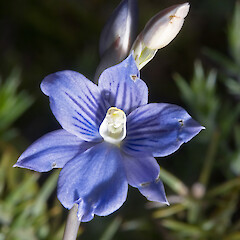Thelymitra cyanea
Common name
swamp sun orchid, striped sun orchid
Synonyms
Macdonaldia cyanea Lindl., Thelymitra venosa sensu Cheeseman nom. inv., Thelymitra uniflora Hook.f.
Family
Orchidaceae
Flora category
Vascular – Native
Endemic taxon
No
Endemic genus
No
Endemic family
No
Structural class
Orchids
NVS code
The National Vegetation Survey (NVS) Databank is a physical archive and electronic databank containing records of over 94,000 vegetation survey plots - including data from over 19,000 permanent plots. NVS maintains a standard set of species code abbreviations that correspond to standard scientific plant names from the Ngä Tipu o Aotearoa - New Zealand Plants database.
THECYA
Chromosome number
2n = 40
Current conservation status
The conservation status of all known New Zealand vascular plant taxa at the rank of species and below were reassessed in 2017 using the New Zealand Threat Classification System (NZTCS) – more information about this can be found on the NZTCS website. This report includes a statistical summary and brief notes on changes since 2012 and replaces all previous NZTCS lists for vascular plants.
Please note, threat classifications are often suggested by authors when publications fall between NZTCS assessment periods – an interim threat classification status has not been assessed by the NZTCS panel.
- Conservation status of New Zealand indigenous vascular plants, 2017 . 2018. Peter J. de Lange, Jeremy R. Rolfe, John W. Barkla, Shannel P. Courtney, Paul D. Champion, Leon R. Perrie, Sarah M. Beadel, Kerry A. Ford, Ilse Breitwieser, Ines Schönberger, Rowan Hindmarsh-Walls, Peter B. Heenan and Kate Ladley. Department of Conservation. Source: NZTCS and licensed by DOC for reuse under the Creative Commons Attribution 4.0 International licence.
2017 | Not Threatened | Qualifiers: SO
Previous conservation statuses
2012 | Not Threatened
2009 | Not Threatened
2004 | Not Threatened
Distribution
Indigenous. New Zealand: North Island, South Island, Stewart Island/Rakiura, Chatham Islands, Auckland Islands. Also Australia.
Habitat
Coastal to montane (up to 800 m a.s.l.) mostly in acidic, often restiad-dominated peat bogs. Also found in damp ground within gumland scrub. This species responds well to frequent disturbance and burning but is able to tolerate dense restiad vegetation and so is often the last sun orchid to persist in dense Sporadanthus F.Muell-dominated vegetation.
Wetland plant indicator status rating
Information derived from the revised national wetland plant list prepared to assist councils in delineating and monitoring wetlands (Clarkson et al., 2021 Manaaki Whenua – Landcare Research Contract Report LC3975 for Hawke’s Bay Regional Council). The national plant list categorises plants by the extent to which they are found in wetlands and not ‘drylands’. The indicator status ratings are OBL (obligate wetland), FACW (facultative wetland), FAC (facultative), FACU (facultative upland), and UPL (obligate upland). If you have suggestions for the Wetland Indicator Status Rating, please contact: [Enable JavaScript to view protected content]
FACW: Facultative Wetland
Usually is a hydrophyte but occasionally found in uplands (non-wetlands).
Detailed description
Terrestrial, tuberous, glabrous, spring to summer-green perennial herb, growing in colonies of 4–20 plants arising through vegetative extension. Plants at flower up to 800 mm tall. Leaf solitary, erect, to suberect, very fleshy to subcoriaceous, longitudinally ribbed, deeply channelled and keeled with margins thickly rounded (appearing trilobed in cross-section), 50–300 × 10–18 mm, green to yellow-green, linear-lanceolate, base closely sheathing. Flowering stem stiffly erect, rather wiry, green to yellow-green. Bracts 1–2–(3), foliaceous, closely-sheathing, fleshy, of similar colour to stem and leaf. Raceme bearing 1–6 flowers. Flowers 10–20 mm diameter, usually blue with darker blue or purple stripes on the petals, dorsal and lateral sepals (very rarely also on labellum); otherwise white with green or pale blue stripes or pink with brown stripes; segments widely spreading, dorsal and lateral sepals slightly narrower and longer than petals. Petals broadly elliptic. Labellum broadly obovate, often slightly crenate, or undulose, apex often mucronate. Column short up to 6 mm long, erect, white, post anther lobe greatly reduced (appearing as if absent) bearing a small area of blister-like crowded calli; column arms yellow more or less erect, ribbon-like, flattened, and twisted inwards one to one-and-a-half times in a loose spiral, apex unevenly lobed without cilia. Anther bent forward, well exposed, apex bifid (appearing as two short horns).
Manaaki Whenua Online Interactive Key
Similar taxa
Most likely to be confused with Thelymitra pulchella Hook.f., a rather variable species which may grow in similar habits, especially in the far north of the North Island and on the Chatham Islands. Thelymitra cyanea is well marked by the usually distinctly darker blue striped flowers, obviously larger, wider, blunt ended and often wavy labellum, absence of a post anther lobe, and whose column arms are yellow, flattened, ribbon-like, mostly spirally twisted and inturned, lack cilia and have unequally bifid apices. The anther is usually fully exposed and the apex distinctly bifid. Thelymitra pulchella is extremely variable but its column arms are much more prominent, mostly toothed, adorned with yellow fimbriae or ciliate. Thelymitra pulchella is a species derived from past hybridisation between T. cyanea and T. longifolia J.R.Forst. et G.Forst.
Flowering
October–March
Flower colours
Blue, Violet/Purple
Fruiting
December–June
Propagation technique
Easily grown if kept in a pot partially submerged in water. However, as with all orchids it should not be removed from the wild.
Etymology
thelymitra: Woman’s hat
Where To Buy
Not commercially available.
Attribution
Description adapted from Moore and Edgar (1970).
References and further reading
Moore LB, Edgar E. 1970. Flora of New Zealand, Volume II. Indigenous Tracheophyta: Monocotyledones except Gramineae. Government Printer, Wellington, NZ. 354 p.
Rolfe JR, de Lange PJ. 2010. Illustrated guide to New Zealand sun orchids, Thelymitra (Orchidaceae). Jeremy Rolfe, Wellington, NZ. 57 p.



















